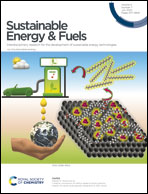Encapsulated Sb and Sb2O3 particles in waste-tire derived carbon as stable composite anodes for sodium-ion batteries
Abstract
A conductive network of waste-tire derived carbon (WTC) was used to produce homogeneous Sb/WTC and Sb2O3/WTC composite materials via ball milling as promising anodes for sodium-ion batteries (SIBs). Highly reversible redox peaks at 0.81/0.71, 0.25 V for Sb/WTC and 0.80/0.76, 0.21/0.26 V for Sb2O3/WTC anodes have been observed related to Na+ intercalation and deintercalation in carbon and Na–Sb and Na3Sb as plausible conversion/alloy reactions. Sodium half-cells delivered reversible discharge capacities of 206 mA h g−1 and 207 mA h g−1 at a current density of 37 mA g−1 for the composite Sb/WTC and Sb2O3/WTC materials, respectively. Both the Sb/WTC and Sb2O3/WTC composite materials showed impressive capacity retention with 85% and 88%, respectively after 100 cycles. Rate capability studies at 60 °C yielded an enhanced capacity of 240 mA h g−1 for Sb/WTC and 300 mA h g−1 for Sb2O3/WTC at 37 mA g−1.



 Please wait while we load your content...
Please wait while we load your content...